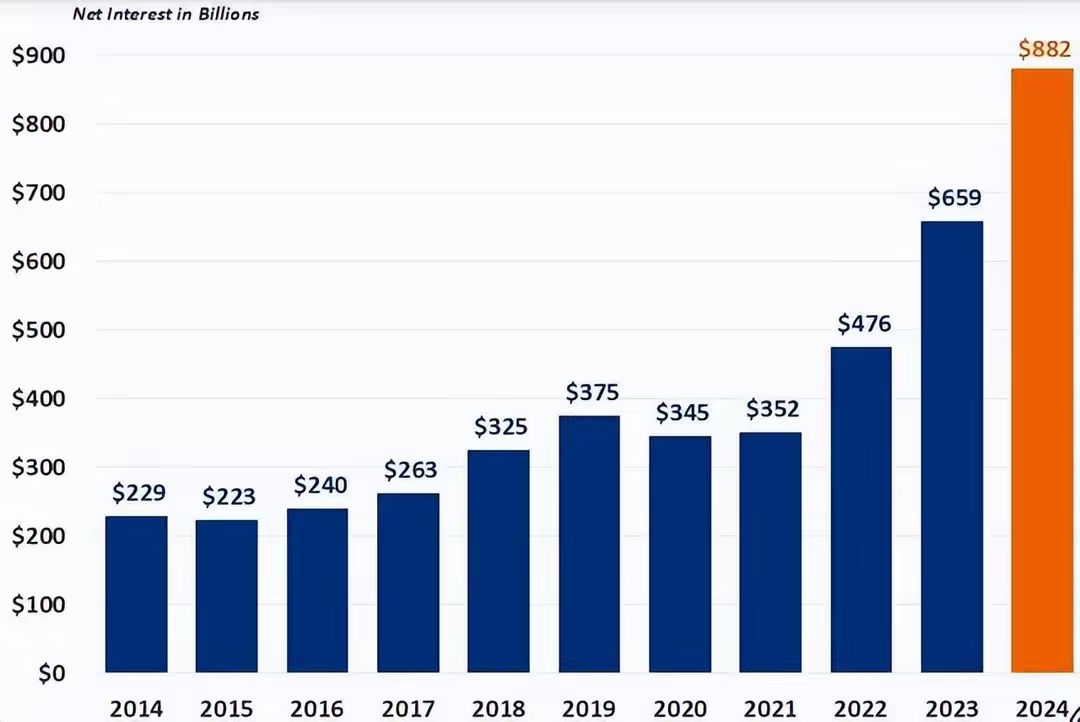
Recently, the total amount of US treasury bond has exceeded 36 trillion US dollars, a record high. From 35 trillion US dollars at the end of July to just over three months now, it has climbed to this amazing figure. This phenomenon is like a heavy bomb thrown into the global economic lake, which has stirred up ripples and profoundly reflected many deep economic problems behind the United States, which is worth our in-depth analysis and examination.
1、 The continuous expansion of fiscal deficit
The continuous record high of the total amount of treasury bond of the United States, first of all, intuitively reflects the long-term expansion of the United States' fiscal deficit that is difficult to contain. The root cause of fiscal deficits lies in the fact that government spending far exceeds revenue. The United States has been pursuing an active fiscal policy for many years, continuously increasing spending in many areas. On the one hand, massive military spending is an important component of fiscal expenditure. The United States has numerous military bases around the world, constantly investing in the research and development of military equipment, updates, and overseas military operations. For example, its military presence in the Middle East consumes huge amounts of financial resources in the long run, but these expenditures are difficult to bring corresponding economic benefits in the short term to offset the costs.
On the other hand, the construction of the welfare system in the United States also requires massive financial support. From social security, medical insurance to unemployment benefits and many other welfare programs, it covers a large population. With the growth of the population and the prominence of issues such as aging, welfare expenditures have shown an increasing trend year by year. At the same time, the U.S. government, in response to economic crisis, public health events and other special circumstances, often introduces large-scale economic stimulus plans to stimulate economic recovery and stabilize social order through financial allocations. For example, after the 2008 financial crisis and during the COVID-19, huge amounts of financial stimulus funds were injected into the market, further increasing the scale of financial spending.
2、 The inherent dilemma of economic growth model
The US treasury bond has repeatedly hit new highs, which also exposes the deep-seated problems of its economic growth model. For a long time, the US economy has shown a growth model that relies on consumption driven growth, with household consumption accounting for a relatively high proportion of GDP. This model is built to a certain extent on the basis of debt, and the American people are accustomed to borrowing and consuming, using various credit tools such as credit cards and housing loans to advance future income to meet current consumption needs.
In order to maintain this high consumption driven economic growth, the US government needs to continuously create a relaxed economic environment, including measures such as maintaining lower interest rates. In a low interest rate environment, borrowing costs for businesses and the public decrease, further stimulating borrowing and consumption behavior. But this has also brought negative effects. On the one hand, excessive consumption has led to a long-term deficit in the US current account, with a large number of goods relying on imports. The domestic manufacturing industry and other real economies have been squeezed to a certain extent, and the problem of industrial hollowing out has gradually become prominent.
3、 Credit Overdraft under the Hegemony of the US Dollar
The continuous expansion of the size of US treasury bond also reflects an overdraft of US currency credit against the background of US dollar hegemony. As the most important reserve currency in the world, the US dollar occupies a dominant position in international trade and international financial markets, which gives the US a unique advantage in issuing treasury bond, because many countries and investors around the world are willing to hold US dollar assets, including US treasury bond, as a relatively safe and liquid investment target.
The United States is taking advantage of this. When facing financial difficulties, it has recklessly issued additional treasury bond, letting other countries around the world "pay" for their fiscal deficits. However, this excessive reliance on the hegemony of the US dollar to maintain the issuance of treasury bond is actually an ongoing overdraft of the credit of the US dollar. With the increasing scale of treasury bond, the market is increasingly worried about whether the United States is able to repay its debt on time and in full. Once this concern breaks a certain critical point and triggers a wave of selling of treasury bond by global investors, the international status of the dollar will be severely hit, and the global financial market will also be in great turmoil.
It is by no means an isolated event that the total amount of treasury bond of the United States has reached a new high. It is like a mirror, which clearly reflects the deep economic problems of the United States in many aspects such as finance, economic growth mode, monetary credit and global economic impact. As this number continues to rise, the global economy has also been dragged into a vortex full of uncertainty and risks. The United States needs to face up to these issues and actively explore sustainable fiscal and economic development paths.

Driven by the Trump administration's push to relax financial regulations and the recovery of investment banking business, the market value of the six major banks in the United States has cumulatively increased by approximately 600 billion US dollars by 2025.
Driven by the Trump administration's push to relax financia…
On Christmas evening, U.S. President Trump posted on social…
According to multiple foreign media reports, the recent fin…
The middle class, once regarded as the cornerstone of Ameri…
On December 19th local time, the US military launched a lar…
The Boxing Day sunshine should have cast a false glow of pr…